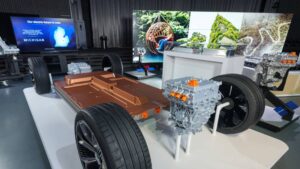Extreme Investor Network Insights: GM’s Strategic Shift in the EV Battery Landscape
In a significant move that highlights the ever-evolving dynamics of the electric vehicle (EV) market, General Motors (GM) recently announced its plan to sell its stake in a $2.6 billion battery cell plant located in Lansing, Michigan. This facility, which is nearing completion, is part of GM’s joint venture with LG Energy Solution (LGES) and represents a crucial element in the automaker’s broader strategy to navigate the complexities of the EV industry.
A Deep Dive into the Deal
On March 4, 2020, GM unveiled its innovative Ultium battery platform, designed to power its transition towards a sustainable electric future. Fast forward to this week, GM stated that it anticipates finalizing a non-binding agreement to transfer its interest in the Lansing plant to LGES, allowing the automaker to recoup about $1 billion of its investment. This plant, set to be the third in a series of joint ventures between GM and LGES, aims to bolster battery production alongside existing facilities in Ohio and Tennessee.
This strategic divestment is both a reflection of GM’s adaptive approach and a response to current market conditions. With consumer demand for EVs not matching earlier projections, the company is making necessary adjustments to maintain financial agility and operational focus.
What This Means for the Future
GM’s decision to offload its stake does not signify a withdrawal from the EV landscape; rather, it emphasizes the company’s commitment to leveraging strong partnerships. The selling of the Lansing plant stake allows LG Energy Solution to access the facility immediately, expediting the installation of critical manufacturing equipment and ensuring that the plant begins operations on schedule, potentially by the end of the year.
In the context of an increasingly competitive market, GM remains dedicated to enhancing its battery technology capabilities. The automaker recently announced that it will extend its 14-year partnership with LGES to include an innovative focus on prismatic battery cells—an exciting development for those in the EV landscape. Prismatic cells, with their space-efficient design, promise to simplify manufacturing while reducing the weight and overall costs of electric vehicles. This pivot aligns well with GM’s goal of optimizing EV performance while enhancing safety.
The Road Ahead
As the EV landscape continues to shift, GM’s proactive strategy represents not just a tactical adjustment, but a broader recognition of the importance of flexibility in production and investment strategies. This move is crucial, especially in light of fluctuating federal incentives and consumer preferences under the current U.S. administration.
With its long-term commitment to battery innovation and strategic partnerships, GM is poised to remain a formidable player in the EV market. The decision to collaborate with LGES, along with plans for a new joint venture with Samsung SDI for another battery plant, further solidifies their stance on a future filled with sustainable electric mobility.
At Extreme Investor Network, we believe that understanding such strategic maneuvers is essential for investors keen on gaining a foothold in the rapidly expanding EV industry. The automotive sector’s shift towards electrification is not only influencing traditional players like GM, but also creating a charge in investment opportunities that require close attention and insightful analysis. Stay connected with us for more in-depth coverage and analysis on the trends that shape our investment landscape!

